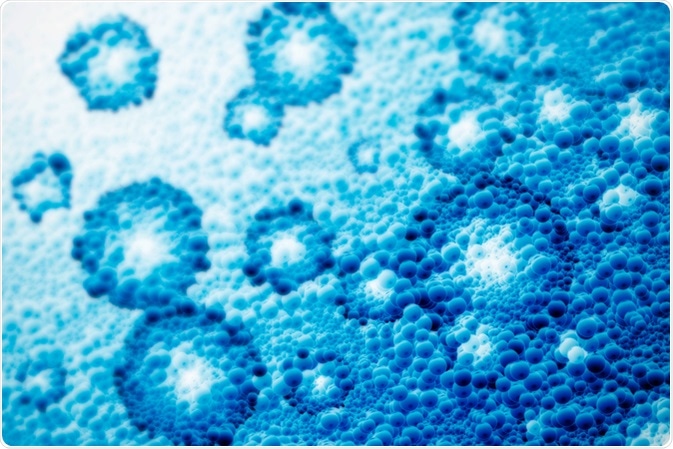Nanoscience is the study of matter at molecular scales. That has been defined as manipulation of matter between the nanometer (nm) and micrometer (um) scale.

Nanospheres - Nanoparticles - Abstract 3D Illustration. Image Credit: GiroScience / Shutterstock
For the purposes of biology, nanoscience is an approach that makes use of materials, devices, and systems that are applicable on a nanometer scale. Most of the mechanisms of life fall at least partially into that size range. Some examples of natural biological entities that measure in the nanometer range are:
- the DNA double helix has a 2 nm diameter
- cell membranes are about 10 nm thick
- eukaryotic cells have a diameter of about 10 um
Similarly, artificial nanostructures can be constructed at those same dimensions. Some examples of these are nanopores with openings of about 2 nm, nanowires of 10 nm diameter, and nanoparticles of 10 to 100 nanometers in diameter. The chemistry and physics of nanomaterials can unique and surprising, and have led to some important innovations in biological science.
Nanoscience and drug delivery -- small particles for big problems | Taylor Mabe | TEDxGreensboro
Measurement
Nanoscale pores can be used to separate molecules by size and biochemical properties. Ion channels are one example of a natural structure than discriminate molecules based on size. An ion channel has a selectivity in the angstrom range, or around one tenth of a nanometer.
Researchers have theorized that the same mechanism can be used to uncoil and separate DNA for sequencing of its nucleotides. In one experiment, a modified natural protein pore, α-hemolysin, was inserted into a somewhat larger synthetic nanopore. The hybrid pore showed an increased selectivity and sensitivity compared to the natural pore, but was more mechanically stable.
Another measurement device that has been created based on nanotechnology is a carbon nanotube sensor for reactive oxygen species (ROS). It had single-molecule resolution based on optical fluorescence quenching. The sensor was able to identify transient “hot spots” of high ROS concentration near the cell membrane.
The next step in nanotechnology | George Tulevski
Microfluidics
Microfluidics is a nanoscale technology for manipulating liquids in droplets of around 1 picoliter, or about 10 um in diameter. The advantage is that effective concentration of reagents is increased at those volumes, while diffusion distance is decreased. This enables greater efficiency for high throughput assays.
Nanoscale materials are useful in clinical diagnostics because their greater surface area can be used to capture biomarkers. Researchers have developed a device for analysis of blood using microfluidic chips with a patterned matrix that uses DNA linkers to bind antibodies. The antibodies detect biomarkers that correlate with cytokine, growth factor, and antigen expression.
Nano-Needles Aid Drug Delivery
Nanotechnology has been used to develop needles that can deliver substances through cell walls without destroying the cell or through human skin less invasively than a hypodermic needle.
A patterned array of silicon nanowires of about 50 nm in diameter and 1 um in height were used to deliver molecular agents into cells to promote the growth of neurons, siRNA knockdown, and inhibition of apoptosis in experiments. They also targeted proteins to organelles.
Another type of nano-needle array was used to deliver drugs to a controlled depth in the skin. The microneedles degrade quickly, leaving no trace.
Sources
- Nanotechnology: emerging tools for biology and medicine, http://genesdev.cshlp.org/content/27/22/2397.full
- Hybrid pore formation by directed insertion of α-haemolysin into solid-state nanopores, https://www.ncbi.nlm.nih.gov/pubmed/21113160?dopt=Abstract
- A clinical microchip for evaluation of single immune cells reveals high functional heterogeneity in phenotypically similar T cells, https://www.ncbi.nlm.nih.gov/pubmed/21602800?dopt=Abstract
- Nanowire-mediated delivery enables functional interrogation of primary immune cells: application to the analysis of chronic lymphocytic leukemia, https://www.ncbi.nlm.nih.gov/pubmed/23190424?dopt=Abstract
- Nanotechnology.gov, https://www.nano.gov/you/nanotechnology-benefits
Further Reading